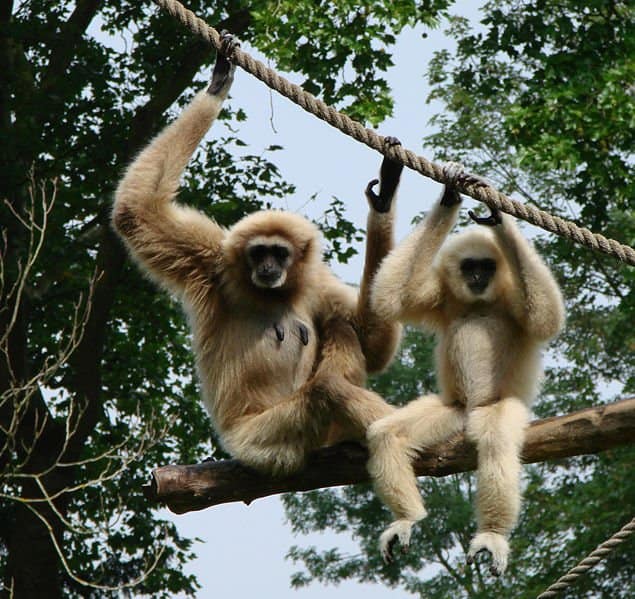Lemurs are found
only on the island of Madagascar and in some close by islands on the east coast
of Africa. Madagascar is an extreme ecological niche for these lemurs to live
in, as they have a rain forest in the east and the west is very dry. They also
experience severe droughts followed by flooding, which causes very little plant
growth. Most lemurs are very social and live in groups of 10-15, comprised of
males and females of all ages. Only nocturnal lemurs are solitary. Lemurs are
seasonal breeders and usually only breed for three weeks every year. They must
time their breeding to deal with the food availability and harsh weather of
Madagascar. They use vocal pitches to communicate with one another. Since
lemurs are the only nonhuman primate living on Madagascar, they have no
competition from other primates to threaten them. Therefore, they have been
free to develop many different social groups, some solitary, some paired, and
some larger groups. However, the island’s extremities have caused them to alter
when they will mate, which only gives them a small window of time to reproduce.
Spider monkeys
live in the tropical rain forests of Central and South America. They are
arboreal, meaning they live in trees, and they deal with high temperatures and
high amounts of rainfall. Spider monkeys are very social and live in groups of
two to three dozen. During the day, they split into smaller groups to forage,
and they do the same at night when they sleep. They can communicate with
another through gestures and different calls and screeches. When a female is
ready to reproduce she chooses her male and they sniff one another to make sure
they are ready for copulation. A female spider monkey usually has one baby
every three to four years. Since spider monkeys live in tropical rainforests,
they are threatened by many predators, including snakes, leopards, and tigers. As
a result, spider monkeys adapted to their environment by forming such large
social groups. In this way, they provide support from one another and are able
to communicate with each other in order to avoid danger.
Baboons live
throughout sub-Saharan Africa and live in many types of regions, including savannas,
mountains, tropical forests, and deserts. Baboons are terrestrial and spend
most of their time on the ground. Their group sizes can range from 10-200,
which is primarily due to which type of environment they live in. Baboons that
live in savannas have much larger groups, as opposed to desert baboons. Females
start reproduction by putting her swollen butt toward a male baboon. After six
months, the baboon gives birth to one baboon. Baboons adapted to their environment
by grouping together as much as they can to find food and water supplies,
especially those that live in the desert.
Gibbons live in
Southeast Asia, islands, and China and live in tropical rainforests. Gibbons
are arboreal and are the fastest at swinging from tree branches. Their social
groups usually include a male, a female, and their offspring. Most gibbons are
monogamous and extremely territorial. They protect their territory by singing
every morning as a warning to predators and other gibbons. They have adapted to
their environment by doing so, since there are many predators that face the
gibbons.
Chimpanzees live
in central Africa in tropical rainforests. However, with deforestation, many
chimpanzees are now forced to find new areas to live. Chimps live in large
communities ranging from 10-100, and often the males of the group form a close
bond. Together, they protect and defend their territory. This is especially
important because of deforestation. Chimps are now even more vulnerable to
attack, since they spend most of their time in trees sleeping and eating. Chimpanzees
do not have seasons of mating; they mate throughout the year when the female is
receptive. Chimps have adapted to their environment by forming large groups
that protect one another and forage together.
Ultimately, I have found the environment that a primate lives in has a huge affect on their behaviors. I also noticed that it had a very similar effect on primates, with most primates forming large groups in order to protect one another from predators and other threats. Additionally, I discovered that mating for some primates was dependent on food supplies and overall conditions.





Great discussion on the relationship between the social and mating patterns of lemurs and the lemur's environment. Good connections.
ReplyDeleteIn general, good coverage on the spider monkey. In comparison with lemurs, spider monkeys can become fertile at any time. This suggests that their environment has a better supply of resources but also that they have to take advantage of reproductive opportunities whenever they can, perhaps because of the increase predation rates? Just a thought.
Good job mentioning the issue of water for baboons which is perhaps their most limited resource. Larger groups may help them compete for access to water, along with the presence of several larger males in the group. Those males may only stick around as long as they have reproductive opportunities.
Good discussion on gibbons and chimpanzees.
Good final summary and good post.
I really liked how you explained in detail how each species develop relationships and eventually mate. For instance I had no idea that spider monkeys screeched in order to communicate with each other. I thought that was pretty cool and also I had no idea baboons would mate they way you wrote. It is kind of weird actually but interesting nonetheless. Great post here and i really liked reading it. Also I liked how you connected environment and mating and why these two are dependent on one another.
ReplyDeleteHey Halle
ReplyDeleteI really enjoyed reading your post. Its very interesting that like humans, chimps don't have a mating season. That could be reason why we are considered to be their closest living relatives. Good post.